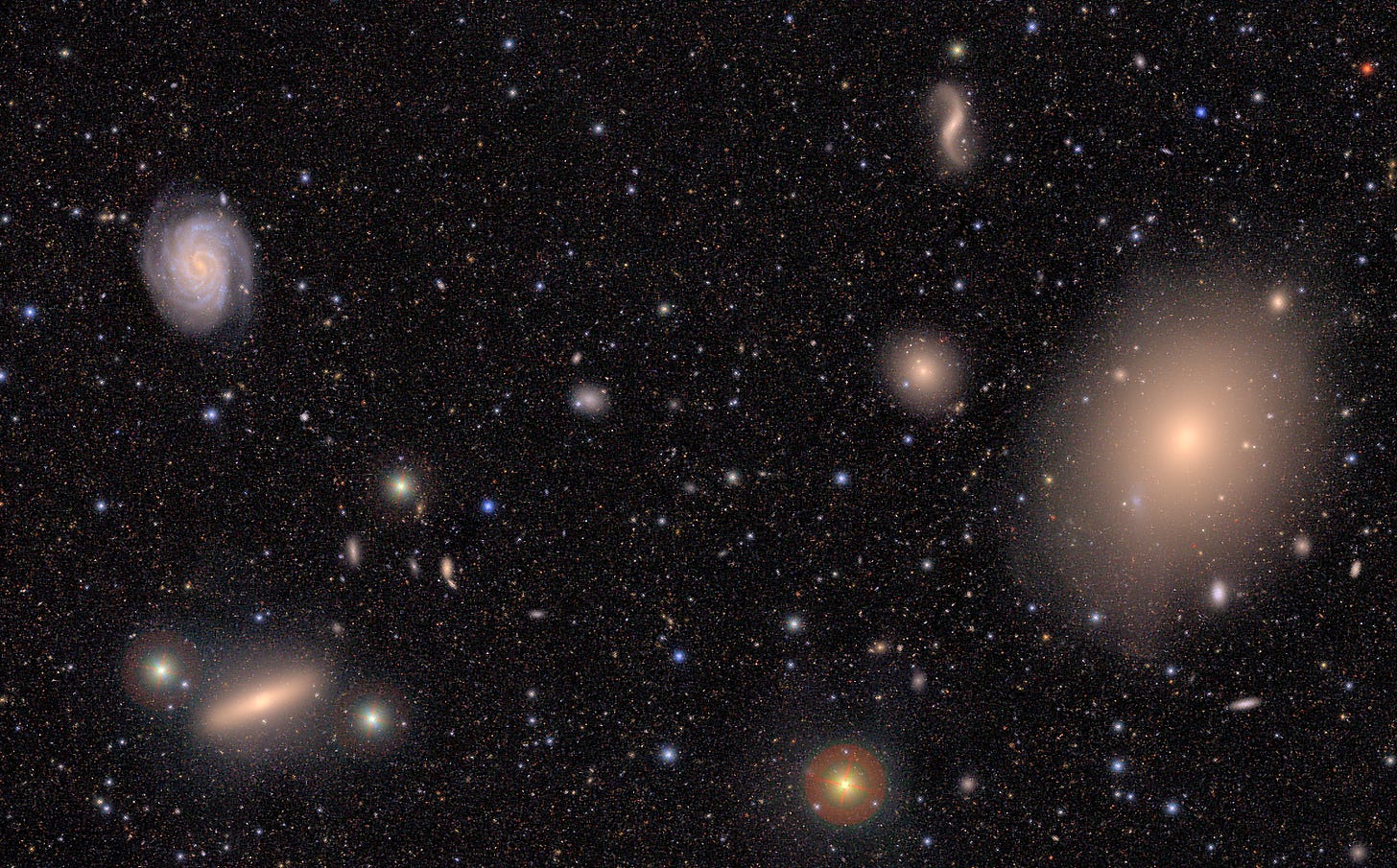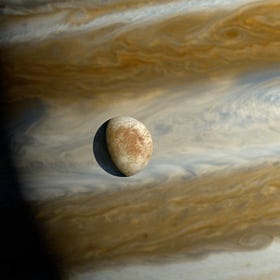The Week in Space and Physics: Vera Rubin’s First Images
On the first images from the Vera Rubin Observatory, the eclipses of Proba-3, a photograph of an exoplanet, and the Axiom-4 mission.
The largest digital camera on Earth can be found on top of a remote mountain in the heart of Chile. It forms the centrepiece of the Vera Rubin Observatory, home to one of the most advanced telescopes ever built by human civilization. And last week, at a conference held by the observatory’s staff, astronomers revealed the first images it has captured.
All, as might be expected, are awe-inspiring. In one, the telescope zoomed in on the Trifid and Lagoon nebulae, capturing the clouds of gas and dust swirling around clusters of new-born stars. In another, the telescope zoomed out, photographing millions of galaxies in and around the Virgo Cluster.
In its first few hours of work, astronomers said, the camera captured ten million galaxies and spotted two thousand new asteroids. Remarkable as that is, this is still a mere fraction of what those astronomers expect the observatory to achieve over the coming decade.
Much of its time will be dedicated to a constant survey of the night sky. The Rubin Observatory is expected to photograph the entire sky every three to four nights. That will result in about twenty terabytes of data per night of work, and around a thousand detailed images of the night sky in total. That, to put the numbers in context, will mean it outstrips every other optical observatory on Earth combined.
All this will help astronomers watch changes in the night sky. Whenever a star explodes or is ripped apart by a black hole, Rubin’s images will help us trace what happened in the moments before. And slower patterns - such as the beat of energy emitted by merging black holes - should be visible in the survey's steady rhythm of images.
Alongside this, the telescope will let astronomers track moving objects in the sky. This includes asteroids. The early haul of two thousand new ones is just the beginning of the five million it is expected to find. But it also includes comets, dwarf planets, interstellar visitors, and even – if any exist – new worlds lurking far beyond the orbit of Neptune.
The observatory, of course, is named for Vera Rubin, the astronomer who pioneered work on dark matter in the 1950s. It is a fitting tribute, then, that the telescope’s observations of galaxies will be used to map the spread of dark matter throughout the cosmos. This effort, especially when paired with the work of Europe’s Euclid telescope, will probe the mysterious framework upon which the visible cosmos is built.
But all this will come in time. For now the telescope is still being prepared for its scientific career. That, engineers say, should begin in earnest in the next three to four months.
For more on the telescope, its camera, and the work it will do, I recommend reading this fantastic article from Science magazine.
Proba-3 Eclipses the Sun
Back in December, I took a look at the ambitious goals of Europe’s new Proba-3 mission. It is, in essence, a huge coronagraph: a device that blocks the bright disk of the Sun to reveal the outer layers of its atmosphere. But unlike any coronagraph before it, Proba-3 achieves this goal by aligning two spacecraft in orbit to create an artificial eclipse.
One of these two spacecraft carries the set of instruments needed to study the Sun’s atmosphere. The other carries the disk that is used to obscure the Sun. Together they move constantly around the Earth, tracing a path that takes them from a height of sixty thousand kilometres to one of just six hundred, after which they begin to rise again.
As they approach the peak of this orbit, the two spacecraft slow down and seek to align themselves. The disk-carrying satellite moves in front of the other, and positions itself perfectly in space to just block out the Sun. In effect, this creates a long-lasting solar eclipse, one controlled in such a way as to allow for detailed scientific work.
Studying the corona – the solar atmosphere – is the main scientific goal of this mission. This layer loops and soars for millions of miles over the Sun’s surface, appearing from Earth to radiate outwards like a crown around our star. Its patterns and movements give birth to the solar wind and play a vital, if poorly understood, role in solar flares and storms. It is also – and for other poorly understood reasons – hot, reaching temperatures ten million degrees above the surface of the Sun.
Of course, observing this corona is not easy. Astronomers must find a stable vantage point, and then precisely block the disk of the Sun. In the case of Proba-3, this means the two spacecraft must align themselves to within a single millimetre over a distance of more than one hundred metres. And then, with this alignment achieved, they must maintain it through careful manoeuvres for up to six hours at a time.
ESA recently announced this task was performed for the very first time in March, just a few months after the mission launched. In a post, the agency outlined how the two spacecraft had acquired formation, held it long enough to observe the corona, and so managed an unparalleled feat of formation flying in space.
Alongside this, ESA published images of the first eclipse created by Proba-3, revealing its view of the corona. This, they say, was the first artificial eclipse created in orbit. It should not be the last: Proba-3, once commissioning and tests are done, should create repeated eclipses for at least the next two years.
A Rare Exoplanet Photograph
Coronagraphs are not just used to study the outer atmosphere of our Sun. They can also be used to block the light of nearby stars and thus to study the fainter objects locked in orbit around them. Indeed, the James Webb telescope is equipped with coronagraphs for exactly this reason.
Astronomers recently used one of them to study a young and nearby star called TWA7. It formed only a few million years ago and is still surrounded by rings of debris. These, we think, are made of comets, asteroids, and young planets. Yet, alongside these the James Webb spotted something unexpected: the faint glow of a large object moving through the rings of debris.
Most likely, the astronomers say, this is a planet the size of Saturn. If so, it is the smallest planet ever to have been directly photographed outside our solar system. And, intriguingly, we might be able to learn more about it in the future. Direct imaging should allow the Webb to gather details about its climate, about the clouds swirling through its skies, and about the way it is shifting the rings of debris closest to it.
But the finding also shows the ability of the James Webb to photograph far-flung worlds. Indeed, the authors of the study reckon the telescope is capable of spotting even smaller planets around comparable stars. There are, it is perhaps worth noting, at least ten thousand stars closer to Earth than TWA7.

Axiom-4 and a Leaky Space Station
The crew of Axiom-4 – including astronauts from India, Hungary, and Poland – reached the International Space Station last Thursday. The launch came two weeks after it was first scheduled to lift off.
The flight was delayed as NASA apparently sought to confirm the safety of the space station. In recent years the station has been suffering from a persistent air leak in the Russian Zvezda module. Shortly before the launch was supposed to happen, Russian cosmonauts carried out a repair effort on these leaks.
This, NASA said, had shifted how air flowed through the station in a way that suggested the leaks had been closed. Still – and for reasons that aren’t entirely clear – NASA chose to continue monitoring air pressures on station for some days. The arrival of Axiom-4, it seems plausible, might have disturbed those measurements. Or, perhaps, the agency was worried about the safety of increasing the station's crew by four.
Either way, the crew arrived safely on board. Speculation about the durability of the station, meanwhile, seems certain to continue.
Read More
The Europa Clipper: Are There Oceans On The Second Moon of Jupiter?
Due to personal commitments I have not been able to write a full article this week. Instead I am making this article, previo…
How Dust on the Ocean Floor Hints at a Recent Near-Earth Supernova
However big you imagine a supernova to be, the reality is certainly bigger. To put it one way, an exploding star can briefly outshine the combined light of every other star in a galaxy; to put it another, a supernova at the distance of Pluto would hit you with more energy than a hydrogen bomb exploding just outside your front door.
How the Einstein Ring Could Help Us Build the Greatest Telescope of All Time
Like almost all good discoveries, this one was made by accident. In September of 2023, two months after Euclid set off on its six-year-long mission to explore the cosmos, the telescope sent back a set of images. They were, quite bluntly, nothing special to look at. Indeed, Euclid’s engineers were not yet interested in pretty pictures of the stars and galaxies, but were instead taking calibrations and checking for ice on the observatory’s instruments.







“Alongside this, ESA published images of the first eclipse created by Proba-3, revealing its view of the corona. This, they say, was the first artificial eclipse created in orbit. It should not be the last …”
Nor, was it the first. Fifty years ago this week, on July 19, 1975, the Apollo half of the Apollo-Soyuz Test Project (ASTP) was used to block the Sun so the corona could be photographed from the Soyuz. It met with mixed results due to the sunlight being diffused by the Apollo’s reaction control thruster gases. Mention of this can actually be found on ESA’s own website.
Also worth mentioning, the crew of Apollo 12 were in a position to observe a solar eclipse while on their way back from the Moon. The Earth, itself, served as the sun-blocking body in that case. The date of that observation was November 21, 1969.